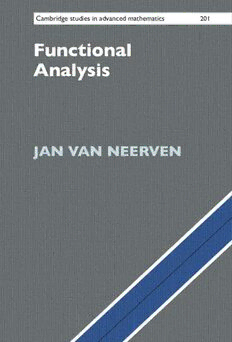Table Of ContentCAMBRIDGE STUDIES IN ADVANCED MATHEMATICS 201
EditorialBoard
J. BERTOIN, B. BOLLOBA´S, W. FULTON, B. KRA, I. MOERDIJK,
C. PRAEGER, P. SARNAK, B. SIMON, B. TOTARO
FUNCTIONALANALYSIS
Thiscomprehensiveintroductiontofunctionalanalysiscoversboththeabstracttheory
and applications to spectral theory, the theory of partial differential equations, and
quantummechanics.Itstartswiththebasicresultsofthesubjectandprogressestowards
a treatment of several advanced topics not commonly found in functional analysis
textbooks,includingFredholmtheory,formmethods,boundaryvalueproblems,semi-
grouptheory,traceformulas,andamathematicaltreatmentofstatesandobservablesin
quantummechanics.
Thebookisaccessibletograduatestudentswithbasicknowledgeoftopology,real
andcomplexanalysis,andmeasuretheory.Withcarefullywrittenoutproofs,morethan
300 problems, and appendices covering the prerequisites, this self-contained volume
canbeusedasatextforvariouscoursesatthegraduatelevelandasareferencetextfor
researchersinthefield.
JanvanNeervenholdsanAntonivanLeeuwenhoekprofessorshipatDelftUniversity
ofTechnology.Authoroffourbooksandmorethan100peer-reviewedarticles,heis
a leading expert in functional analysis and operator theory and their applications in
stochasticanalysisandthetheoryofpartialdifferentialequations.
CAMBRIDGE STUDIES IN ADVANCED MATHEMATICS
EditorialBoard
J.Bertoin,B.Bolloba´s,W.Fulton,B.Kra,I.Moerdijk,C.Praeger,P.Sarnak,B.Simon,B.Totaro
AllthetitleslistedbelowcanbeobtainedfromgoodbooksellersorfromCambridgeUniversityPress.
Foracompleteserieslisting,visitwww.cambridge.org/mathematics.
AlreadyPublished
160 A.Borodin&G.OlshanskiRepresentationsoftheInfiniteSymmetricGroup
161 P.WebbFiniteGroupRepresentationsforthePureMathematician
162 C.J.Bishop&Y.PeresFractalsinProbabilityandAnalysis
163 A.BovierGaussianProcessesonTrees
164 P.SchneiderGaloisRepresentationsand(ϕ,(cid:3))-Modules
165 P.Gille&T.SzamuelyCentralSimpleAlgebrasandGaloisCohomology(2ndEdition)
166 D.Li&H.QueffelecIntroductiontoBanachSpaces,I
167 D.Li&H.QueffelecIntroductiontoBanachSpaces,II
168 J.Carlson,S.Mu¨ller-Stach&C.PetersPeriodMappingsandPeriodDomains(2ndEdition)
169 J.M.LandsbergGeometryandComplexityTheory
170 J.S.MilneAlgebraicGroups
171 J.Gough&J.KupschQuantumFieldsandProcesses
172 T.Ceccherini-Silberstein,F.Scarabotti&F.TolliDiscreteHarmonicAnalysis
173 P.GarrettModernAnalysisofAutomorphicFormsbyExample,I
174 P.GarrettModernAnalysisofAutomorphicFormsbyExample,II
175 G.NavarroCharacterTheoryandtheMcKayConjecture
176 P.Fleig,H.P.A.Gustafsson,A.Kleinschmidt&D.PerssonEisensteinSeriesandAutomorphic
Representations
177 E.PetersonFormalGeometryandBordismOperators
178 A.OgusLecturesonLogarithmicAlgebraicGeometry
179 N.NikolskiHardySpaces
180 D.-C.CisinskiHigherCategoriesandHomotopicalAlgebra
181 A.Agrachev,D.Barilari&U.BoscainAComprehensiveIntroductiontoSub-RiemannianGeometry
182 N.NikolskiToeplitzMatricesandOperators
183 A.YekutieliDerivedCategories
184 C.DemeterFourierRestriction,DecouplingandApplications
185 D.Barnes&C.RoitzheimFoundationsofStableHomotopyTheory
186 V.Vasyunin&A.VolbergTheBellmanFunctionTechniqueinHarmonicAnalysis
187 M.Geck&G.MalleTheCharacterTheoryofFiniteGroupsofLieType
188 B.RichterCategoryTheoryforHomotopyTheory
189 R.Willett&G.YuHigherIndexTheory
190 A.BobrowskiGeneratorsofMarkovChains
191 D.Cao,S.Peng&S.YanSingularlyPerturbedMethodsforNonlinearEllipticProblems
192 E.KowalskiAnIntroductiontoProbabilisticNumberTheory
193 V.GorinLecturesonRandomLozengeTilings
194 E.Riehl&D.VerityElementsof∞-CategoryTheory
195 H.KrauseHomologicalTheoryofRepresentations
196 F.Durand&D.PerrinDimensionGroupsandDynamicalSystems
197 A.ShefferPolynomialMethodsandIncidenceTheory
198 T.Dobson,A.Malnicˇ&D.MarusˇicˇSymmetryinGraphs
199 K.S.Kedlayap-adicDifferentialEquations
Functional Analysis
JAN VAN NEERVEN
DelftUniversityofTechnology
UniversityPrintingHouse,CambridgeCB28BS,UnitedKingdom
OneLibertyPlaza,20thFloor,NewYork,NY10006,USA
477WilliamstownRoad,PortMelbourne,VIC3207,Australia
314–321,3rdFloor,Plot3,SplendorForum,JasolaDistrictCentre,
NewDelhi–110025,India
103PenangRoad,#05–06/07,VisioncrestCommercial,Singapore238467
CambridgeUniversityPressispartoftheUniversityofCambridge.
ItfurtherstheUniversity’smissionbydisseminatingknowledgeinthepursuitof
education,learning,andresearchatthehighestinternationallevelsofexcellence.
www.cambridge.org
Informationonthistitle:www.cambridge.org/9781009232470
DOI:10.1017/9781009232487
©JanvanNeerven2022
Thispublicationisincopyright.Subjecttostatutoryexception
andtotheprovisionsofrelevantcollectivelicensingagreements,
noreproductionofanypartmaytakeplacewithoutthewritten
permissionofCambridgeUniversityPress.
Firstpublished2022
AcataloguerecordforthispublicationisavailablefromtheBritishLibrary.
ISBN978-1-009-23247-0Hardback
CambridgeUniversityPresshasnoresponsibilityforthepersistenceoraccuracyof
URLsforexternalorthird-partyinternetwebsitesreferredtointhispublication
anddoesnotguaranteethatanycontentonsuchwebsitesis,orwillremain,
accurateorappropriate.
Contents
Preface pageix
NotationandConventions xi
1 BanachSpaces 1
1.1 BanachSpaces 2
1.2 BoundedOperators 9
1.3 Finite-DimensionalSpaces 18
1.4 Compactness 21
1.5 IntegrationinBanachSpaces 23
Problems 28
2 TheClassicalBanachSpaces 33
2.1 SequenceSpaces 33
2.2 SpacesofContinuousFunctions 34
2.3 SpacesofIntegrableFunctions 47
2.4 SpacesofMeasures 64
2.5 BanachLattices 73
Problems 77
3 HilbertSpaces 87
3.1 HilbertSpaces 87
3.2 OrthogonalComplements 92
3.3 TheRieszRepresentationTheorem 95
3.4 OrthonormalSystems 97
3.5 Examples 100
Problems 106
4 Duality 115
4.1 DualsoftheClassicalBanachSpaces 115
4.2 TheHahn–BanachExtensionTheorem 128
4.3 AdjointOperators 137
v
vi Contents
4.4 TheHahn–BanachSeparationTheorem 142
4.5 TheKrein–MilmanTheorem 144
4.6 TheWeakandWeak∗Topologies 147
4.7 TheBanach–AlaogluTheorem 152
Problems 163
5 BoundedOperators 171
5.1 TheUniformBoundednessTheorem 171
5.2 TheOpenMappingTheorem 174
5.3 TheClosedGraphTheorem 176
5.4 TheClosedRangeTheorem 178
5.5 TheFourierTransform 180
5.6 TheHilbertTransform 190
5.7 Interpolation 192
Problems 201
6 SpectralTheory 209
6.1 SpectrumandResolvent 209
6.2 TheholomorphicFunctionalCalculus 216
Problems 224
7 CompactOperators 227
7.1 CompactOperators 227
7.2 TheRiesz–SchauderTheorem 230
7.3 FredholmTheory 234
Problems 252
8 BoundedOperatorsonHilbertSpaces 255
8.1 Selfadjoint,Unitary,andNormalOperators 255
8.2 TheContinuousFunctionalCalculus 266
8.3 TheSz.-NagyDilationTheorem 272
Problems 277
9 TheSpectralTheoremforBoundedNormalOperators 281
9.1 TheSpectralTheoremforCompactNormalOperators 281
9.2 Projection-ValuedMeasures 285
9.3 TheBoundedFunctionalCalculus 287
9.4 TheSpectralTheoremforBoundedNormalOperators 293
9.5 TheVonNeumannBicommutantTheorem 301
9.6 ApplicationtoOrthogonalPolynomials 305
Problems 308
10 TheSpectralTheoremforUnboundedNormalOperators 311
10.1 UnboundedOperators 311
Contents vii
10.2 UnboundedSelfadjointOperators 322
10.3 UnboundedNormalOperators 326
10.4 TheSpectralTheoremforUnboundedNormalOperators 332
Problems 344
11 BoundaryValueProblems 347
11.1 SobolevSpaces 347
11.2 ThePoissonProblem−Δu= f 372
11.3 TheLax–MilgramTheorem 385
Problems 388
12 Forms 399
12.1 Forms 399
12.2 TheFriedrichsExtensionTheorem 410
12.3 TheDirichletandNeumannLaplacians 411
12.4 ThePoissonProblemRevisited 415
12.5 Weyl’sTheorem 416
Problems 425
13 SemigroupsofLinearOperators 427
13.1 C -Semigroups 427
0
13.2 TheHille–YosidaTheorem 439
13.3 TheAbstractCauchyProblem 447
13.4 AnalyticSemigroups 455
13.5 Stone’sTheorem 473
13.6 Examples 475
13.7 SemigroupsGeneratedbyNormalOperators 498
Problems 500
14 TraceClassOperators 507
14.1 Hilbert–SchmidtOperators 507
14.2 TraceClassOperators 510
14.3 TraceDuality 521
14.4 ThePartialTrace 523
14.5 TraceFormulas 526
Problems 539
15 StatesandObservables 543
15.1 StatesandObservablesinClassicalMechanics 543
15.2 StatesandObservablesinQuantumMechanics 545
15.3 PositiveOperator-ValuedMeasures 561
15.4 HiddenVariables 574
15.5 Symmetries 577
viii Contents
15.6 SecondQuantisation 598
Problems 617
AppendixA Zorn’sLemma 621
AppendixB TensorProducts 623
AppendixC TopologicalSpaces 627
AppendixD MetricSpaces 637
AppendixE MeasureSpaces 647
AppendixF Integration 661
AppendixG Notes 671
References 691
Index 701
Preface
ThisbookisbasedonnotescompiledduringthemanyyearsItaughtthecourse“Ap-
plied Functional Analysis” in the first year of the master’s programme at Delft Uni-
versityofTechnology,forstudentswithpriorexposuretothebasicsofRealAnalysis
and the theory of Lebesgue integration. Starting with the basic results of the subject
coveredinatypicalFunctionalAnalysiscourse,thetextprogressestowardsatreatment
ofseveraladvancedtopics,includingFredholmtheory,boundaryvalueproblems,form
methods,semigrouptheory,traceformulas,andsomemathematicalaspectsofQuantum
Mechanics. With a few exceptions in the later chapters, complete and detailed proofs
are given throughout. This makes the text ideally suited for students wishing to enter
thefield.
Greatcarehasbeentakentopresentthevarioustopicsinaconnectedandintegrated
way, and to illustrate abstract results with concrete (and sometimes nontrivial) appli-
cations. For example, after introducing Banach spaces and discussing some of their
abstractproperties,asubstantialchapterisdevotedtothestudyoftheclassicalBanach
spacesC(K),Lp(Ω),M(Ω),withsomeemphasisoncompactness,density,andapproxi-
mationtechniques.Theabstractmaterialinthechapterondualityiscomplementedbya
numberofnontrivialapplications,suchasacharacterisationoftranslation-invariantsub-
spacesofL1(Rd)andProkhorov’stheoremaboutweakconvergenceofprobabilitymea-
sures.ThechapteronboundedoperatorscontainsadiscussionoftheFouriertransform
andtheHilberttransform,andincludesproofsoftheRiesz–ThorinandMarcinkiewicz
interpolationtheorems.AftertheintroductionoftheLaplaceoperatorasaclosableop-
eratorinLp,itsclosureΔisrevisitedinlaterchaptersfromdifferentpointsofview:as
the operator arising from a suitable sesquilinear form, as the operator −∇(cid:2)∇ with its
naturaldomain,andasthegeneratoroftheheatsemigroup.Inparallel,thetheoryofits
Gaussiananalogue,theOrnstein–Uhlenbeckoperator,isdevelopedandtheconnection
withorthogonal polynomialsandthe quantumharmonicoscillator is established.The
chapteronsemigrouptheory,besidesdevelopingthegeneraltheory,includesadetailed
treatment of some important examples such as the heat semigroup, the Poisson semi-
ix

